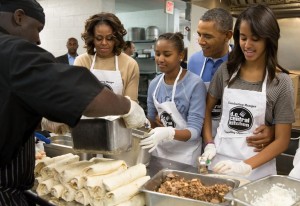New Clean Power Plan begs the question: What about a Clean Food Plan?
A new “Clean Power Plan” has been announced by President Obama, asking U.S. state governments to create tailored plans to meet the goal of reducing U.S. carbon dioxide emissions by 32 percent from 2005 levels by the year 2030. But the plan does not provide what projections indicate is needed.
The International Energy Agency projects that climate outcomes may no longer be controllable if the whole world does not reduce a significant amount of carbon in our atmosphere by 2020. Yet most of the emissions reductions in the new U.S. plan are set to be achieved after 2020, when Mr. Obama will no longer be president.
Indeed, national governments of virtually all countries worldwide have promised to act on reversing climate change, and have collectively spent billions of dollars to do so – mainly by financing renewable energy – for more than 20 years. However, during that period, greenhouse gas emissions have increased by 61 percent.
Still, national governments are clearly not about to stop addressing climate change. Yet those who believe that climate change is happening – and also those who don’t – surely do not want to see greenhouse gas emissions continue to rise while governments continue to spend billions on renewable energy to reverse climate change.
In fact, using renewable energy to reverse climate change is projected to take long past the time by which significant emissions reduction is said to be needed (by 2020); it’s been projected to cost $36.5 trillion and be completed no sooner than the year 2035,
However, there is a solution for which it doesn’t matter whether people believe that climate change is happening or not. That’s because regardless of what anyone believes, it’s a fact that disruptive climate events (such as droughts) are increasingly causing large-scale die-offs of livestock and crops that feed them.
As a result, disruptive climate events have helped to create a business case to replace animal products with better alternatives. Better alternatives are foods consisting of – or made from – grains, legumes, and nuts, such as peas, soybeans, and almonds. It’s widely recognized that replacing livestock products with better alternatives can have a large beneficial effect on climate change.
Notably, though, the business case for replacing livestock products with better alternatives doesn’t require that governments act, or that people believe that climate change is happening, or that it’s caused by humans.
This business case exists because food production uniquely occurs outdoors – so food companies suffer more directly from disruptive climate events than any other part of our economy.
As a result, food companies will soon have to make products that require many fewer crops to be grown. The only significant question may be whether food companies will do so before or after disruptive climate events force them to do so (and before such events cause great harm).
It takes many fewer crops to produce alternatives to livestock products. Moreover, almost every livestock product now has a plant-based alternative that tastes about the same.
Equally important, replacing livestock products with better alternatives can be done in less than a year, as that’s how long it takes to produce most livestock products and alternatives. That’s in stark contrast to the time it takes to replace fossil fuel infrastructure with renewable energy infrastructure – as most infrastructure has a lifespan of at least 20 years, and infrastructure is almost never replaced before the end of its useful lifespan.
So developing renewable energy can’t respond to changing demands in real time. In contrast, there’s a long and strong track record of developing food products to respond to changing demands in more or less real time.
If using a business case to replace animal-based foods with plant-based foods on a large scale by 2020 sounds improbable, let’s remember that Steve Jobs and Bill Gates acted on a business case for producing and marketing new technology to replace old technology on a global scale within a few years.
Indeed, using a business case is a well-trod pathway that’s successfully replaced millions of consumer products worldwide, including tube TVs, dial phones, cassette tapes, big cars, New Cokes, McLean Burgers, and much more.
For example, Ethan Brown factored in climate change in creating a new company called Beyond Meat to replace livestock products with better alternatives. Just as startups Microsoft and Apple once inspired the world’s top computer businesses to replace obsolete technology with new technology, today’s startups such as Beyond Meat may be able to get today’s top food businesses to replace obsolete foods with new foods. An argument for this process to be undertaken has notably been made by Bill Gates,
Some people will predictably doubt whether large-scale switching from animal-based foods to plant-based ones can really happen by 2020. But it surely can happen if one thinks of animal-based foods as being obsolete in our modern age of climate change.
For example, tube TVs and horse-drawn carriages were widely loved in their heydays— yet once they were perceived as obsolete, they were completely replaced within a few years by automobiles and digital TVs.
So no matter what politicians are doing, there’s still hope to reverse climate change – with our forks.




Trackback: Real Leadership Now. – Syntrina Leadership